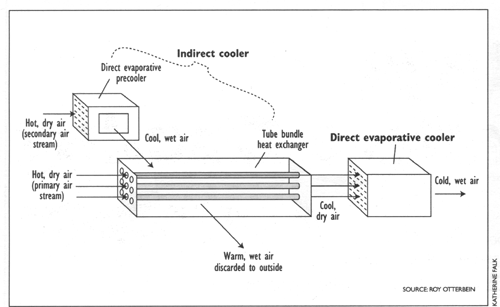two-stage evaporative cooler

A two-stage evaporative cooler is an advanced type of evaporative cooler, also known as an indirect/direct cooler, that produces cool air with a much lower relative humidity than that produced by a traditional single-stage evaporative cooler. Two-stage evaporative coolers can be effective in hot, dry environments, such as desert regions, for which the single-stage variety is not viable. Typically, they can reduce the temperature of outside air by as much as 50°F (for example, from 115°F to 65°F), while delivering air that is less humid than that from a single-stage system.
In the first (indirect) stage, incoming warm air passes through a water-filled heat exchanger that cools without adding moisture. In the second (direct) stage, air passes through a water-soaked pad where the temperature drops more and the air picks up water, which increases the humidity. Because the air supply to the second stage evaporator is pre-cooled, less humidity is added to the air (because cooler air can't hold as much moisture as warmer air). The result is cool air with a relative humidity between 50 and 70%, depending on the climate, compared to a single-stage system that produces about 80% relative humidity air.
In most installations, air is delivered directly through the wall, or it can be ducted to one or two central locations. Air exits the home through vents to the attic, which cools the attic and further reduces heat gain.
An advanced two-stage evaporative cooler uses 100% filtered, outdoor air and a variable speed blower to circulate cool air. Two-stage evaporative coolers can reduce energy consumption by 60 to 75% over conventional air conditioning systems, according to the American Society of Heating and Engineers (ASHRAE). Yet this relative improvement depends on location and application. Evaporative coolers work best in very dry climates.
